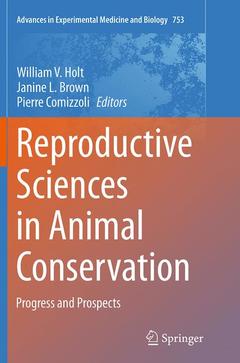Reproductive Sciences in Animal Conservation, Softcover reprint of the original 1st ed. 2014 Progress and Prospects Advances in Experimental Medicine and Biology Series, Vol. 753
Coordonnateurs : Holt William V., Brown Janine L., Comizzoli Pierre

Introduction: Reproductive science as an essential component of conservation biology.- “Mayday Mayday Mayday”, the millennium ark is sinking!.- Climate change, extinction risks, and reproduction of terrestrial vertebrates.- Impacts of endocrine disrupting chemicals on reproduction in wildlife.- The role of genomics in conservation and reproductive sciences.- The epigenetic basis of adaptation and responses to environmental change: perspective on human reproduction.- The Black-footed Ferret: On the Brink of Recovery?.- Comparative reproductive biology of elephants.- The koala (Phascolarctos cinereus): A case study in the development of reproductive technology in a marsupial.- Reproduction and Advances in Reproductive Studies in Carnivores.- Methods to examine reproductive biology in free-ranging, fully-marine mammals.- Amphibian declines in the 21st century: Why we need assisted reproductive technologies.- The reality, use and potential for cryopreservation of coral reefs.- Recent advances and prospects in germplasm preservation of rare and endangered species.- Sperm DNA fragmentation and its role in wildlife conservation.- Somatic Cells, Stem Cells, and Induced Pluripotent Stem Cells: How do they now contribute to conservation?.- Biosafety in embryos and semen cryopreservation, storage, management and transport.- Fertility Control in wildlife: review of current status, including novel and future technologies.- Cloning the mammoth: a complicated task or just a dream?.- Conclusions: environmental change, wildlife conservation and reproduction.
Date de parution : 09-2016
Ouvrage de 533 p.
15.5x23.5 cm


